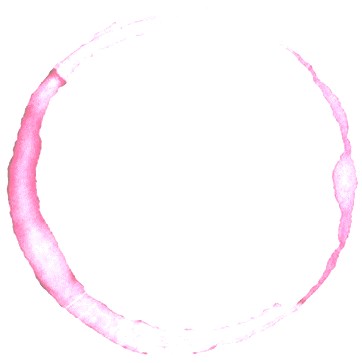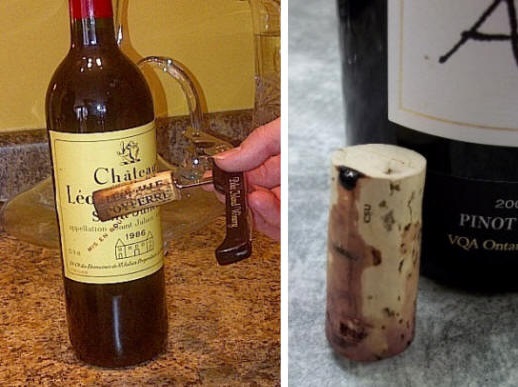
< Previous / Next >
 |
Article Index < Previous / Next > |

OH, THE PRESSURE!
- cork etiquette while dining out
 You'd
think the task of ordering a bottle off a restaurant`s wine list would be
reasonably straightforward and uneventful: pick something interesting or
familiar, get the dude in the bow tie to pour it for you, and sit back and
enjoy. Yet this one exercise will cause more undue stress in the
minds of restaurant patrons than any other related task that evening.
And judging by the
number of questions I receive expressing concern over this activity, the topic is in need of some clarification.
You'd
think the task of ordering a bottle off a restaurant`s wine list would be
reasonably straightforward and uneventful: pick something interesting or
familiar, get the dude in the bow tie to pour it for you, and sit back and
enjoy. Yet this one exercise will cause more undue stress in the
minds of restaurant patrons than any other related task that evening.
And judging by the
number of questions I receive expressing concern over this activity, the topic is in need of some clarification.
The issue at hand is that depending on the formality of the establishment in
question, the waiter - or sommelier appears to require some form of
acknowledgement and permission-to-proceed before pouring said bottle. With
that, I'd like to instil a degree of confidence in those who typically order
their wine with a side of doubt.
Common sense should prevail in these situations and a quick glance at the
bottle will confirm that it was not opened (or worse, refilled) prior to
arriving at your table. Additionally, the label should match what you have
asked for. Your nod of approval will then initiate the serving
process.
With the entire dinner party sitting in a state of unnecessary paralysis,
the sommelier will remove the cork from the bottle and place it on a saucer
or side-plate before the host of the dinner party - you. But here lies the
question and source of discomfort for many diners: what are you expected you
to do with the cork? Should you smell it? That seems to be the common
practice. I actually know of a person who licks it - and another who once
threw it across the table in rebuttal to the ensuing laughter created by the
exercise. So what then, is the etiquette involved with the presentation of
the cork?
An acceptable response would be to do nothing at all. That's easy; don't
even acknowledge the awkwardness of the situation and simply let the server
pour the sample to taste. The unfortunate truth is that 9 out of 10 waiters
who serve wine on a daily basis don't know why they present the cork either.
It’s just been done that way for as long as anyone can remember.
If you do decide to take the bait, here's what you need to know about cork
etiquette:
Don't smell the cork; save that technique for the wine instead. It makes no
difference whatsoever how aromatically complex or offensive the cork is when
you are likely to give the wine a swirl and sniff anyway. Remember, older
bottles display older characteristics: dried fruit, leather, solvent/petrol,
and numerous other creative forest floor-type adjectives. Barolo and
Bordeaux do not exhibit the same popular spunk as the big reds from
California, Argentina, and Australia. Old-world wines tend to show a more
earth-driven complexity while the product of modern wine regions and
winemaking typically display a greater degree of fruit-forward character.
If you plan to purchase luxury wine at some point in the future, it is worth
developing a habit of matching the cork to the bottle - and we're talking
very high end wine now, not a $12 label from Gallo marked up to an alarming $36.
The top bottles from the best producers usually have the vintage date stamped on
the cork. One would assume that the date on the cork and the date on the
bottle will coincide, yet at the uppermost end of the drinking spectrum,
counterfeiting, while by no means rampant, is an unfortunate truth.
There is no need to fret over the idea of being cheated, but a
moment spent matching names and numbers is not a bad practice.
Observe the staining on the cork created be the wine itself. The base
of the stopper is always discoloured by the colour pigment of the wine - but
does the wine stain appear on the side of the cork as well? If so, how far
up does it travel? Due to the gradual breakdown of the cork’s elasticity
over time, some degree of staining on the side of a stopper drawn from an
older bottle is expected. If the full length of the cork is discoloured by
the wine, I'd be suspicious of storage conditions and the potential for an
oxidized (flawed) bottle. Evidence of wine seepage from the bottle
during storage is indicated by any amount of residue on the top of the cork.
Better wine service will assure that a bottle of this nature is not served -
but that also cuts into profits and therefore as a consumer, you must be aware of
the telltale signs of a defective bottle.

The entire bottle acceptance
process takes less that 30 seconds and will become effortless with a few
dinners under your belt. Ordering wine with a meal is not meant to be
complicated; we create that perception ourselves – but these tips will help
you maximize your dining experience.
Oh, by the way, if the bottle comes topped with a screw cap closure,
the airtight seal must crack when the top is twisted off. If so, there is no additional
concern - unless of course they start labelling the rubber gasket thingy
inside the cap with contest rewards. In that case, make sure it says 'Try
Again' before buddy with the bow tie takes off with your winning sweepstakes cap!
| return to the Article Index | ||
Tyler Philp is a member of the Wine Writers' Circle of Canada Please direct inquires for writing services to: info@tylerphilp.com |
||
| Copyright © 2013 Tyler Philp
prior permission required for duplication of material |
||